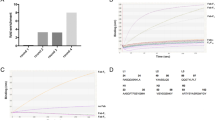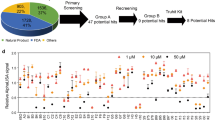Summary
Cytotoxic effects ofcis-diamminedichloroplatinum-(II) (cis-DDP) are thought to be mediated by binding to DNA. Studies on binding ofcis-DDP to cellular DNA rely heavily on the availability of specific antibodies. We therefore, raised and characterized four rabbit antisera: one againstcis-DDP-modified DNA (antiserum NKI-A59) and three others against thecis-DDP-modified (di)nucleotidescis-Pt(NH3)2d(pApG) (NKI-A68),cis-Pt(NH3)2d(GMP)2(NKI-A10), and Pt(NH3)3dGMP (NKI-A39). Reactivities to platinum compounds were determined in an enzyme-linked immunosorbent assay (ELISA) and in a quantitative immunocytochemical assay. In the ELISA, NKI-A59 showed a high affinity for DNA heavily substituted with eithercis-DDP or CBDCA [cis-diammine (1,1-cyclobutanedicarboxylato)platinum(II)]; amounts of platinum per well giving 50% inhibition (IA50) were as low as 15 and 76 fmol, respectively. NKI-A59 also showed affinity tocis-DDP-modified poly[d(G-C)] poly[d(G-C)], poly(dC), and poly(dG). No affinity was found fortrans-DDP [trans-diamminedichloro-platinum(II)]-modified DNA, enzymatically digestedcis-DDP-DNA, orcis-DDP-modified poly(dA)., poly(dT), oligo(dA) −15 , oligo(dT) −15 , oligo(dG)21, oligo(dG)42, or oligo(dAAAG)10. The efficiency of binding tocis-DDP-DNA decreased with decreasing DNA modification levels. Although othercis-DDP-DNA- andcis-DDP-(di)nuclcotide-specific antisera have been identified, NKI-A59 is the first antiserum described that is suitable for the in situ detection ofcis-DDP-DNA adducts at clinically relevant platinum levels. Adduct-specific immunostaining signals in cultured RIF-1 cells or rat liver paralleled platinum-DNA binding as measured by atomic absorption spectroscopy. The antisera NKI-A68, NKI-A10, and NKI-A39 showed high affinity for their corresponding haptens and varying affinity for non-haptencis-DDP-DNA adducts. Their affinity for digestedcis-DDP-modified DNA was up to 30 times that for intactcis-DDP-DNA. Neither NKI-A68 nor NKI-A10 resulted in specific immunocytochemical staining ofcis-DDP-DNA adducts. We conclude that NKI-A68, NKI-A10, and NKI-A39 are suitable for platinum-DNA adduct analysis of digested DNA in ELISA and that NKI-A59 is suitable for platinum-DNA adduct detection at the single-cell level using immunocytochemical methods.
Similar content being viewed by others
Abbreviations
- cis-DDP:
-
cis-diamminedichloroplatinum(II)
- trans-DDP:
-
trans-diamminedichloroplatinum(II)
- CBDCA:
-
cis-diammine (1,1-cyclobutanedicarboxylato)platinum(II)
- DACH-PT:
-
[sp-4-2-(1R,2R)]-(1,2-diaminecyclohexane)dichloroplatinum(II)
- Pt-GG:
-
cis-Pt(NH3)2]d(pGpG)-N7(1),N7(2)]
- Pt-AG:
-
cis-Pt(NH3)2[d(pApG)-N7(1), N7(2)]
- G-Pt-G:
-
cis-Pt(NH3)2 [5′-dGMP-N7]2
- Pt-G:
-
Pt(NH3)3-[5′-dGMP-N7]
- CT-DNA:
-
ealf thymus DNA
- Rb :
-
platinum-nucleotide ratio; bp, base pairs
- IA50 :
-
amount of inhibitor per microtiter well giving 50% inhibition in a competitive ELISA
- BSA:
-
bovine serum albumin; ELISA, enzyme-linked immunosorbent assay
- HPLC:
-
high-pressure liquid chromatography
References
Dijt F (1989) Investigation of the reaction products of carboplatin with DNA. Thesis, University of Leiden
Dijt FA, Chottard JC, Giraults JP, Reedijk J (1989) Formation and structure of reaction products ofcis-PtCl2(NH3)2 with d(ApG) and/or d(GpA) in di-, tri-, and penta-nucleotides. Preference for GpA chelation over ApG chelation. Eur J Biochem 179: 333
Eastman A (1986) Reevaluation of interaction ofcis-dichloro(ethylenediamine)platinum(II) with DNA. Biochemistry 25: 3912
Fichtinger-Schepman AMJ, Van der Veer JL, Lohman PHM, Reedijk J (1984) A simple method for the inactivation of monofunctionally DNA-boundcis-diamminedichloroplatinum(II). J Inorg Biochem 21: 103
Fichtinger-Schepman AMJ, Baan RA, Luiten-Schuite A, Van Dijk M, Lohman PHM (1985) Immunochemical quantitation of adducts induced in DNA bycis-diamminedichloroplatinum(II) and analysis of adduct-related DNA-unwinding. Chem-Biol Interact 55: 275
Fichtinger-Schepman AMJ, Van der Veer JL, Den Hartog JHJ, Lohman PHM, Reedijk J (1985) Adducts of the antitumor drugcis-diamminedichloroplatinum(II) with DNA: formation, identification, and quantitation. Biochemistry 24: 707
Fichtinger-Schepman AMJ, Van Oosterom AT, Lohman PHM, Berends F (1987)cis-Diamminedichloroplatinum(II)-induced DNA adducts in peripheral leukocytes from seven cancer patients: quantitative immunochemical detection of the adduct induction and removal after a single dose ofcis-diamminedichloroplatinum(II). Cancer Res 47: 3000
Fichtinger-Schepman AMJ, Baan RA, Berends F (1989) Influence of the degree of DNA modification on the immunochemical determination of cisplatin-DNA adduct levels. Carcinogenesis 10: 2367
Försti A, Laatikainen R, Hemminki K (1987) Mono- and bifunctional binding ofcis-diamminedichloroplatinum(II) to dinucleotides. Chem-Biol Interact 63: 1
Girault JP, Chottard G, Lallemand JY, Chottard JC (1982) Interaction ofcis-[Pt(NH3)2(H2O)2](NO3)2 with ribose and deoxyribose diguanosine phosphates. Biochemistry 21: 1352
Halloran MJ, Parker CH (1966) The preparation of nucleotide-protein conjugates: carbodiimides as coupling agents. J Immunol 96: 373
Hemminki K, Ludlum DB (1981) Covalent modification of DNA by antineoplastic agents. J Natl Cancer Inst 73: 1021
Kirby KS, Cook EA (1967) Isolation of deoxyribonucleic acid from mammalian tissues. J Biochem 104: 254
Knox RJ, Friedlos F, Lydall DA, Roberts JJ (1986) Mechanism of cytotoxicity of anticancer platinum drugs: evidence thatcis-diamminedichloroplatinum(II) andcis-diammine-(1,1-cyclobutanedicarboxylato)platinum(II) differe only in the kinetics of their interaction with DNA. Cancer Res 46: 1972
Kriek E, Welling M, Laken CJ van der (1984) Quantitation of carcinogen-DNA adducts by standard high-sensitive enzyme immunoassay. In: Berlin A, Draper M, Hemminki K, Vainio H (eds) Monitoring human exposure to carcinogenic and mutagenic agents. IARC Scientific Publication 59. International Agency for Research on Cancer, Lyon, p 297
Kriek E, Schooten FJ van, Hillebrand MJX, Welling MC (1988) Binding efficiency of antibodies to DNA modified with aromatic amines and polycyclic aromatic hydrocarbons. Implications for quantification of carcinogen-DNA adducts in vivo. In: Bartsch H, Hemminki K, O'Neill IK (eds) Methods for detecting DNA damaging agents in humans: applications in cancer epidemiology and prevention. IARC Scientific Publication 89. International Agency for Research on Cancer, Lyon, p 201
Lippard SJ (1982) New chemistry of an old molecule:cis-[Pt(NH3)2Cl2]. Science 218: 1075
Lippard SJ, Ushay HM, Merkel CM, Poirier MC (1983) Use of antibodies to probe the stereochemistry of antitumor platinum drug binding to deoxyribonucleic acid. Biochemistry 22: 5165
Malfoy B, Hartmann B, Macquet JP, Leng M (1981) Immunochemical studies of DNA modified bycis-dichlcrodiammineplatinum(II) in vivo and in vitro. Cancer Res 41: 4127
Marcelis ATM, Van Kralingen C, Reedijk J (1980) The interaction ofcis- andtrans-diamminedichloroplatinum compounds with 5′-guanosine monophosphate and 5′-deoxyguanosine monophosphate. a proton NMR investigation. J Inorg Biochem 13: 213
Morin-Faure J, Marcollet M (1983) Immunocytochemical study of the action ofcis-dichlorodiammine platinum on the human metaphase chromosome. Eur J Cell Biol 30: 316
Morita H, Bailar JC (1983) Triamminechloroplatinum (II) chloride. Inorg Synth 22: 124
Newman RA, Nishikawa K, Stasny J, Khokhar AR, Krakoff IH, Rosenblum MG (1989) Determination of intracellular distribution of platinum drugs by immunohistochemical and analytical electron microscopy techniques (abstract). Proc Am Assoc Cancer Res 30: A1866
Poirier MC, Lippard SJ, Zwelling LA, Ushay HM, Kerrigan D, Thill CC, Santella RM, Grundberger D, Yuspa SH (1982) Antibodies elicited againstcis-diamminedichloroplatinum(II)-modified DNA are specific forcis-diamminedichloroplatinum(II)-DNA adducts formed in vivo and in vitro. Proc Natl Acad Sci USA 79: 6443
Poirier MC, Reed E, Zwelling LA, Ozols RF, Litterst CL, Yuspa SH (1985) Polyclonal antibodies to quantitatecis-diamminedichloroplatinum(II)-DNA adducts in cancer patients and animal models. Environ Health Perspect 62: 89
Rahmouni A, Leng M (1987) Reaction of nucleic acids withcis-diamminedichloroplatinum(II): interstrand cross-links. Biochemistry 26: 7229
Reed E, Ozols RF, Tarone R, Yuspa SH, Poirier MC (1987) Platinum-DNA adducts in leukocyte DNA correlate with disease response in ovarian cancer patients receiving platinum-based chemotherapy. Proc Natl Acad Sci USA 84: 5024
Reedijk J (1987) The mechanism of action of platinum antitumor drugs. Pure Appl Chem 59: 181
Reedijk J, Fichtinger-Schepman AMJ, Van Oosterom AT, Van de Putte P (1987) Platinum amine coordination compounds as antitumor drugs. Molecular aspects of the mechanism of action. Struct Bonding (Berlin) 67: 53
Roberts JD, Moore AL, Hackers MP (1988) ELISA for DACH-Pt-DNA adducts (abstract). Proc Am Assoc Cancer Res 29: A1385
Rosenberg B (1985) Fundamental studies with cisplatin. Cancer 55: 2303
Scherer E, Van Benthem J, Terheggen PMAB, Vermeulen E, Winterwerp HHK, Den Engelse L (1987) Immunocytochemical analysis of DNA adducts at the single cell level: a new tool for experimental carcinogenesis, chemotherapy, and molecular epidemiology. In: Bartsch H, Hemminki K, O'Neill IK (eds) Methods for detecting DNA damaging agents in humans: applications in cancer epidemiology and prevention. IARC Scientific Publication 89. International Agency for Research on Cancer, Lyon, p 286
Sundquist WI, Lippard SJ, Stollar BD (1987) Monoclonal antibodies to DNA modified withcis- ortrans-diamminedichloroplatinum(II). Proc Natl Acad Sci USA 84: 8225
Terheggen PMAB, Floot BGJ, Scherer E, Begg AC, Fichtinger-Schepman AMJ, Den Engelse L (1987) Immunocytochemical detection of interaction products ofcis-diamminedichloroplatinum(II) andcis-diammine(1,1-cyclobutanedicarboxylato)platinum(II) with DNA in rodent tissue sections. Cancer Res 47: 6719
Terheggen PMAB, Begg AC, Floot BGJ, Emondt J, Den Engelse L (1988) Visualization of cisplatin-DNA and carboplatin-DNA adducts in tissues and cultured cells. In: Nicolini M, Bandolini G (eds) Proceedings of the 5th International Symposium on Platinum and Other Metal Coordination Compounds in Cancer Chemotherapy. Martinus Nijhoff, Boston The Hague Dordrecht Lancaster, p 139
Terheggen PMAB, Dijkman R, Begg AC, Dubbelman R, Floot BGJ, Hart AAM, Den Engelse L (1988) Monitoring of interaction products ofcis-diamminedichloroplatinum(II) andcis-diammine(1,1,-cyclobutanedicarboxylato)platinum(II) with DNA in cells from platinum treated cancer patients. Cancer Res 48: 5597
Terheggen PMAB, Gerritsen van der Hoop R, Floot BGJ, Gispen WH (1989) Cellular distribution ofcis-diamminedichloroplatinum(II)-DNA binding in rat dorsal root spinal ganglia: effect of the neuroprotecting peptide Org. 2766. Toxicol Appl Pharmacol 99: 334
Terheggen PMAB, Emondt JY, Floot BGJ, Schrier PI, Den Engelse L, Begg AC (1990) Correlation between cell killing bycis-diamminedichloroplatinum(II) in six mammalian cell lines and binding of acis-diamminedichloroplatinum(II)-DNA antiserum. Cancer Res 50: 3556
Terheggen P, Reed E, Michael C, Begg A, Muggia F, Den Engelse L (1990) Platinum-DNA binding in patients treated with cisplatin and carboplatin (abstract). Proc Am Assoc Cancer Res 31: A1975
Tilby MJ, Styles JM, Dean CJ (1987) Immunological detection of DNA damage caused by melphalan using monoclonal antibodies. Cancer Res 47: 1542
Twentyman PR, Brown JM, Gray JW, Franko AJ, Scoles MA, Kallman RF (1980) A new mouse tumour model system (RIF-1) for comparison of end-point studies. J Natl Cancer Inst 64: 595
Van der Marel G, Van Boeckel CAA, Wille G, Van Boom JH (1981) A new approach to the synthesis of phosphotriester intermediates of nucleosides and nucleic acids. Tetrahedron Lett 22: 3887
Watt GW, Cude WA (1986) Diethylenetriammine complexes of platinum(II) halides. Inorg Chem 7: 335
Zwelling LA, Kohn KW (1979) Mechanism of action ofcis-dichlorodiammineplatinum(II). Cancer Treat Rep 63: 1439
Author information
Authors and Affiliations
Rights and permissions
About this article
Cite this article
Terheggen, P.M.A.B., Floot, B.G.J., Lempers, E.L.M. et al. Antibodies against cisplatin-modified DNA and cisplatin-modified (di) nucleotides. Cancer Chemother. Pharmacol. 28, 185–191 (1991). https://doi.org/10.1007/BF00685507
Received:
Accepted:
Issue Date:
DOI: https://doi.org/10.1007/BF00685507




